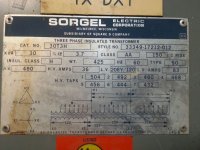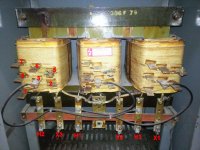maxh
Hot Rolled
- Joined
- Dec 5, 2005
- Location
- Austin, TX
3-phase Transformer, Y in, delta out: Put neutral on the input? (running it backwards
Basically the title says it all. I have a 3 phase transformer (Square D 30T3H) in which the input windings are hooked up in a Y configuration and the output a delta. On the input, do I hook up the neutral?
Edit: I edited the title to reflect that I'll be running this transformer "backwards" (not that transformers care.) See my post 2 down for pics of the transformer and name plate.
Basically the title says it all. I have a 3 phase transformer (Square D 30T3H) in which the input windings are hooked up in a Y configuration and the output a delta. On the input, do I hook up the neutral?
Edit: I edited the title to reflect that I'll be running this transformer "backwards" (not that transformers care.) See my post 2 down for pics of the transformer and name plate.
Last edited:






